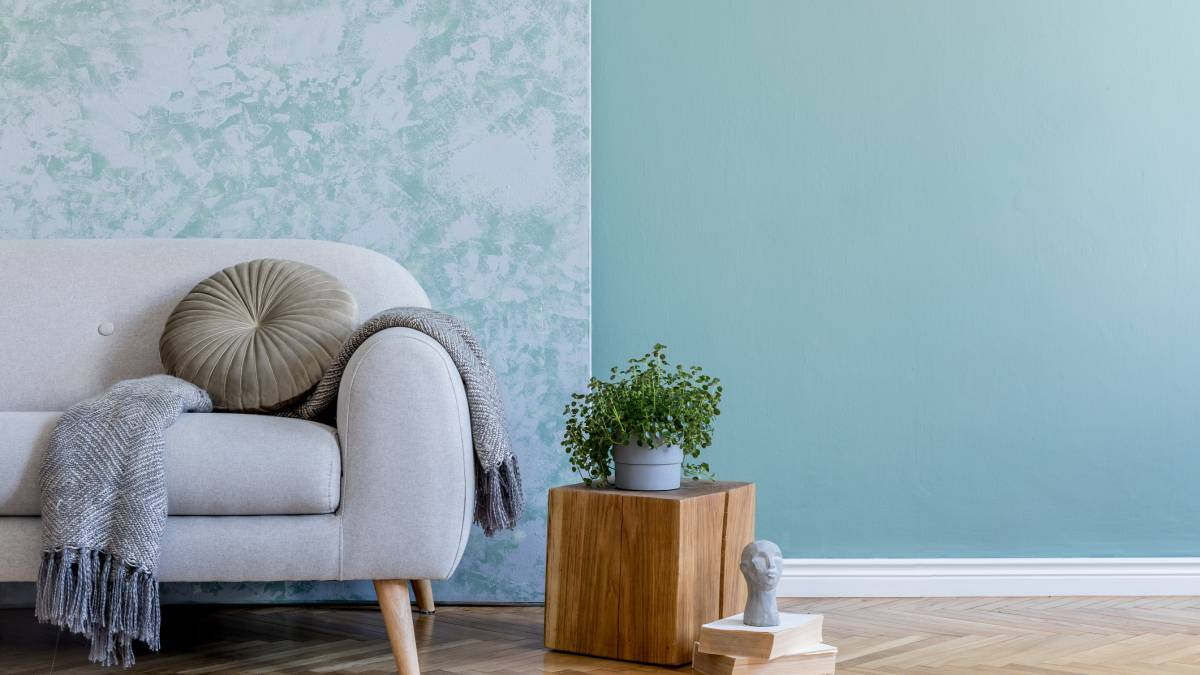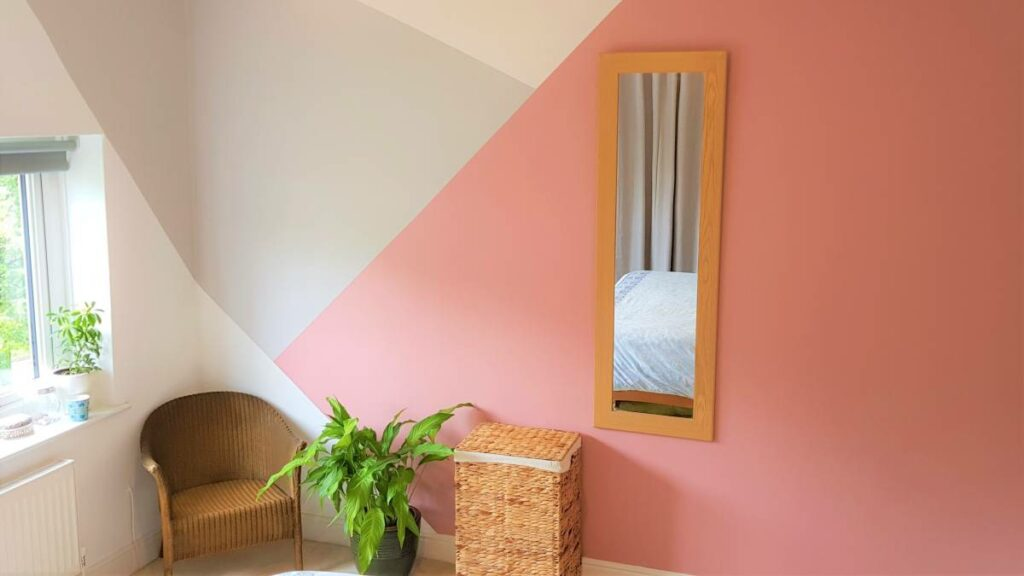
Find a local painter
- Inspiration /
- Indoor projects /
- Design & decor /
- Creative wall painting...
Creative wall painting techniques
Unleash your creativity and personality through your walls with these wall painting techniques.
Nothing refreshes your home like a new coat of paint. A tastefully chosen paint colour and style can enhance the visual impact, set the mood of your space, and reflect your desired interior aesthetic. With a few tools and some hours to spare, you can use these wall painting techniques to give any room the redesign it needs.
10 different paint techniques for walls
Sponge painting

Sponge painting is a simple painting method to redesign your interior walls. This technique is especially effective when painting over painted walls to add texture and depth.
How to do it:
Prepare a sponge paint roller or a natural sea sponge and your desired paint colour. Next, dip your sponge into your paint of choice and dab it lightly over the wall. You can either create a thin layer of paint for a muted effect or a thicker layer to add focus to your space. Avoid excessive force when dabbing your sponge. You can use a smaller sponge for touch-ups.
Colour washing
Colour washing is a painting method that blends two colours, layering one over the other, to create that soft texture effect. The most recommended approach to this method is using lighter and darker hues of the same colour or choosing complementary shades for that dramatic tint effect.
If you want a dynamic look for your room, colour washing is one of the simplest textured painting techniques for walls.
How to do it:
First, apply an even coat of your base colour. You can use a brush, sponge, or rag to do this. When the base coat is dry, use a thin coat of your second colour with the glaze. The ratio of glaze to paint varies depending on your desired result, but if you want a subtle effect, put more glaze. Then, apply the second colour in random strokes or dabs while letting your base coat show.
Rag rolling
If you’re looking for an easy way to add nuance and warmth to your interior, rag rolling is the way to go. This simple painting technique can add sophistication and depth to small areas such as powder rooms.
How to do it:
Start by saturating a rolled-up rag into your top coat of choice. Next, crumple your rag to form folds and creases–this will be your rag pattern. Press your rag onto the wall to create a textured pattern on the surface. A pro tip is to spread out your application at first for consistent results.
Tape art patterns

A roll of painter’s tape is one of the most useful and affordable items to have in your painting toolkit. When used creatively, painter’s tape can create crisp lines and patterns that fit the aesthetic of any room. For example, checkerboard patterns are one of the easiest ways to use this technique to paint your wall.
How to do it:
Prepare a neutral base coat and another paint of your desired colour. Apply the tape on the wall in your desired shape. Then, paint over the areas; you can use different colours for each shape. Let the paint dry and apply more coats, if necessary.
Stippling
Stippling is a wall painting technique that involves applying paint with a brush in a dabbing motion. When done correctly, the pointed texture of the brush creates a speckled, rich texture akin to suede. This method can give a room more depth or even hide any flaws in old wall paint.
How to do it:
Before you begin, make sure your brush is pointed perpendicular to the wall. This will ensure that the peaks of paint form instead of being flat on the surface. Apply your paint by making dabs on the wall to accomplish the stippled effect.
Patterned rollers
If you prefer the accessibility and convenience a paint roller brings, you’ll be happy to know you can use it to create stunning textures. Patterned paint rollers have raised patterns on their cover, such as flower patterns, allowing for a seamless transfer of the decorative paint onto the surface.
How to do it:
Dip your roller in a thin coat of paint, then apply from top to bottom in a straight and even motion. Avoid applying too much pressure when painting on your wall to achieve a more consistent result.
Striping

This one’s easy and simple. Striping is essentially painting vertical or horizontal stripes on your wall to create a focal point in your room. If you want to have the feel of a loftier ceiling, consider designing your room with vertical stripes. On the other hand, go with horizontal lines if you want to make your space feel wider.
How to do it:
Begin by marking off the areas you want to paint on with painter’s tape. Use a ruler to ensure the spaces between the tapes are uniform. Then, paint over every other section to achieve the striped effect.
Trowel for texture
Using a trowel creates a look that mimics the appearance of Venetian Plaster. This effect is due to the trowel smoothing paint over the wall instead of a brush applying paint with rough bristles.
How to do it:
Take a spatula and apply a thin line of paint on your trowel. Note that less is more when painting with a trowel, as smaller amounts of paint are easier to control. Then, slop the paint on the wall and gently smooth your trowel across the surface.
Decoupage
Consider using the decoupage technique for a design to jazz up your space, especially for more personal spaces like your bedroom. This approach involves decorating a wall with paint and paper or fabric decals combined with a water-based sealer like Mod Podge.
How to do it:
Start by applying your sealer on the surface, then place your chosen pieces on the wall. Allow 15 to 20 minutes for the sealant to dry, then add another coat. Add a matte or glossy finish to complete your project.
Half-painted wall

Repainting your wall with the half-painted method is a brilliant idea if you want a different yet simple design for your space: paint half of the wall in one colour and the other half in a different colour.
For example, bold and intense colours such as navy, dark grey, and black on one half of the wall can create a striking balance with neutrals such as white, beige, or taupe on the other half. On the other hand, using two neutral hues, such as cream and green-grey, makes for a safe yet tasteful design choice.
How to do it:
Begin by placing a strip of masking tape just below your dividing line. Paint the wall with a lighter colour first, and then let dry. After about an hour of drying, place a masking tape just before the edge of your first colour. Paint the rest of the surface with your second colour.
Give your walls a much-needed redesign
A fresh coat of paint on your walls is the easiest way to revitalise any interior space. With a few supplies and one free day, you can use these wall painting techniques to upgrade your home. If you’re not comfortable painting walls yourself, or if you want to ensure a professional-looking finish, you can always hire a professional painter to help.
FAQs on wall painting techniques
What is the correct order to paint a room?
If you’re repainting the whole room, begin with the ceilings. Once the ceiling is dry, you can start painting the walls. After that, paint the trim (e.g. baseboards, door, and window frames) with a brush. Lastly, paint the floor. Make sure to use special paint for floors if you are painting the whole room.
How do you paint a wall creatively?
You can add creative flair to your wall project with any painting technique, such as sponge painting, rag rolling, and striping. What’s most important is that your wall reflects your aesthetic and personality.
How do you paint walls differently?
Painting walls can vary in colour, technique, and finish. You can use colours to reflect the mood of various rooms. When it comes to technique, consider what texture best fits the room. As for the finish of a wall, your choices range from a flat finish to a high-gloss finish. Each of these has unique characteristics that affect the overall look of your room.
What are some techniques for painting?
Painting techniques like colour washing, sponge painting, and rag rolling are perfect for creating shadows or blending colours. Meanwhile, you can use tape art to create geometric shapes and patterns to draw a focal point in your room. You can even use decoupage to achieve a collage-like effect on your walls.
How much will your job cost?
The Oneflare Cost Guide Centre is your one-stop shop to help you set your budget; from smaller tasks to larger projects.



